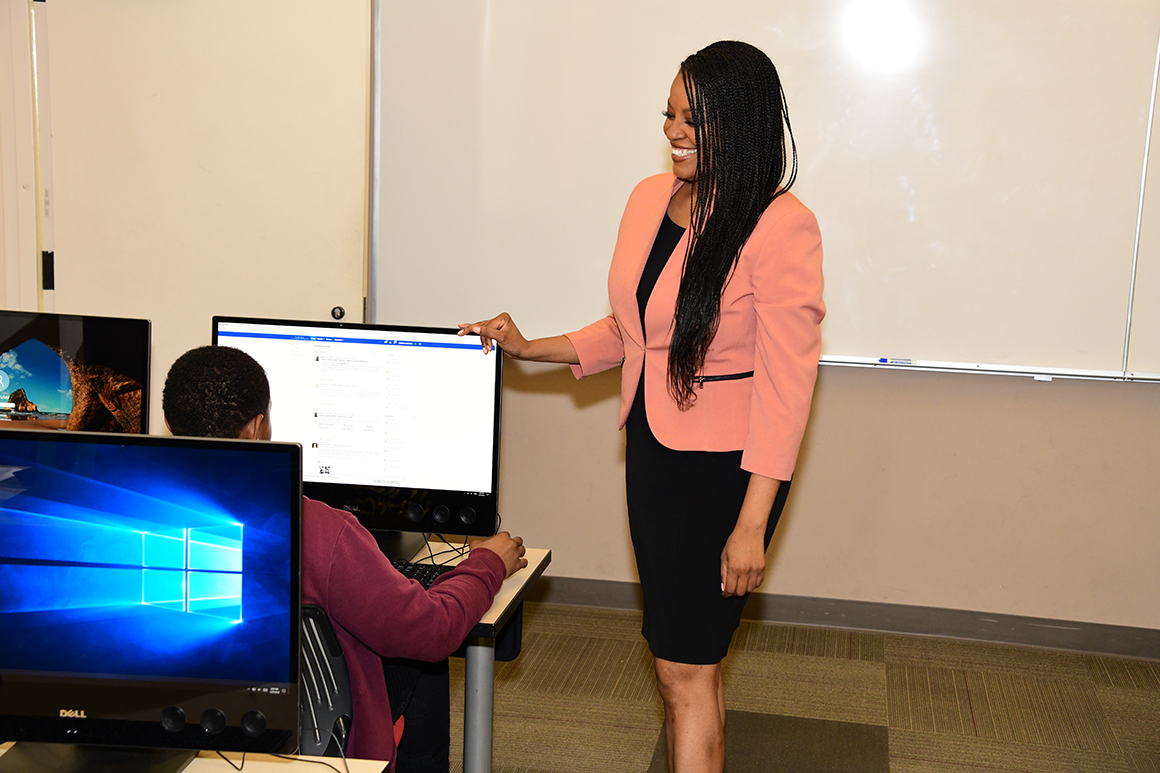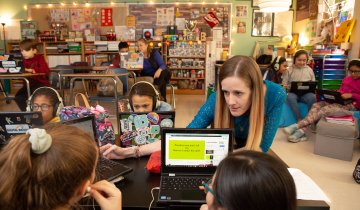Sound-absorbing sneakers, remote piloting system and a kinetic energy-absorbing suit.
If you’ve seen “Black Panther,” then you’ve gotten a glimpse of inventions like these — creations that make Wakanda the most technologically advanced nation on Earth. While such inventions do require a bit of the fictional metal vibranium, there’s no denying that they’re birthed in the workshop of the movie’s heroine, Princess Shuri, a Black teenage girl who might as well have “STEM Genius” tattooed across her forehead.
But not only are STEM masterminds usually white men in the movies — like Iron Man’s Tony Stark or James Bond’s Q — that’s who students tend to see presented as real-life STEM role models, too. Evan Spiegel, Sergey Brin, Mark Zuckerberg. These are household names in America. What’s the effect on Black and Latino kids who consume technology created by White tech bros, all while never hearing their own math or science teachers mention innovators of color?
And how should the nation’s schools effectively educate the real-life Shuris who are growing up without equal access to the experienced teachers, classroom materials and advanced coursework they need to succeed in a technology-driven economy?
Those are some of the questions that Brendesha Tynes, an associate professor of education and psychology at USC Rossier, hopes to answer through her new role as director of the Center for Empowered Learning and Development with Technology at USC Rossier. CELDTech, which launched in October, will “be the premiere center,” says Tynes, “for guidance on integrating technology in schools that serve Black and Latino kids, and the place that people look to for methodologically rigorous research on these populations.”
Igniting a spark
In particular, Tynes has a laser focus on transforming the nature of research on the intersection of technology, education and race. Under her leadership, CELDTech’s team already has a half dozen projects up and running, ranging from studying how urban schools and communities incorporate blended, project-based learning to researching the ways electronic devices are being used to boost academic and social-emotional learning of students of color.
Tynes, who was born and raised in Detroit, knows firsthand what it’s like to have an educational experience that affirms and centers your background. “I had a really amazing school experience from pre-K all the way through high school,” she says with a laugh. But it was an elementary school African History Club that, says Tynes, “informs a lot of the work that I do now.” Mr. James, the teacher who led the club, taught Tynes and her peers culturally relevant lessons that weren’t included during regular classroom instruction.
“We were learning about Paul Robeson and reading Langston Hughes poems,” says Tynes. Mr. James lit such a fire under the kids that one school year the students even raised money to travel to Egypt. And along with building students’ entrepreneurial capacities and sense of cultural self-worth, Mr. James also built their academic skills. “In fourth grade, I was writing and editing our newsletter,” says Tynes.
The spark ignited by the club fueled Tynes, the daughter of a single mother, to be editor of the school yearbook, the vice president of her senior class and the president of the National Honor Society. Degrees from Columbia, Northwestern and UCLA soon followed. “From African History Club I had the attitude that if I could — it sounds cliché — but if I could imagine it for myself, then it was possible,” says Tynes. “I wondered what it would be like for kids today to have the kinds of experiences that set them up to be their absolute best selves.”
Seeing themselves in STEM
To that end, Tynes says she deliberately included the phrase “Empowered Learning” in the name of the center. “When I think of an empowered learner,” she says, “I think of kids having more agency in terms of their educational experiences, kids seeing themselves in the materials they read, being able to solve problems in their communities using technology and being able to critique those structures in society that keep certain groups at one position and other groups in another.”
Survey data released in January by the Pew Research Center shows that the majority of Americans — 80 percent — say that racial and ethnic diversity in the workplace is important. However, nearly 60 percent of Black Americans working in a STEM job say their workplace doesn’t pay enough attention to increasing racial and ethnic diversity, significantly more than the 15 percent of White Americans who say this is the case.
In the spirit of transparency, Facebook released data in August that revealed only 3 percent of employees doing technical jobs at the company are Hispanic and a mere 1 percent are Black — abysmal diversity numbers that are the norm in Silicon Valley.
“If we wanted to address the racial diversity problem, we would,” says Tynes. “Instead, we give small amounts of money and other resources, but not enough to actually move the needle.”
Other Silicon Valley leaders have posited that what matters the most is that a company has a diversity of viewpoints. During an October panel discussion about fighting racial injustice, Denise Young Smith, Apple’s former vice president of diversity and inclusion, raised eyebrows when she told the crowd, “There can be 12 White, blue-eyed, blond men in a room and they’re going to be diverse, too, because they’re going to bring a different life experience and life perspective to the conversation.”
“There are some who feel race isn’t a factor because if a student has access to a computer, they can get on Khan Academy or YouTube and learn,” says Tynes. “In other cases, people feel that only certain populations are interested and are able to master STEM-related subject matter.”
How widespread are ingrained racial stereotypes and erroneous ideas about fixed vs. growth intelligence and STEM? One indicator might be that, according to the Pew research, 45 percent of STEM workers believe that Black and Hispanic students being “less interested” in STEM is a reason lower numbers of Americans from those backgrounds are employed in STEM fields.

For Tynes, the problem isn’t that students of color aren’t interested in STEM. Instead, “the discrimination they face in the classroom, the lack of rigor in the curriculum, the lack of meaningful learning experiences — all of these factors play a role,” she says. “Black children come to elementary schools bouncing off the walls with an eagerness to learn. I’ve seen firsthand the academic spirit that wells up in them and makes them excited to read and do math and science. And then slowly but surely, by high school, we beat it out of many of them.”
Pew also found that roughly three-fourths of STEM workers say that the biggest obstacle to racial diversity in STEM fields is that Blacks and Hispanics are less likely to have access to a quality education to prepare them for these fields. A June 2016 report from the U.S. Department of Education’s Office for Civil Rights found that majority-Black and Latino high schools are less likely to offer classes in STEM subjects, including basics such as algebra II, chemistry and physics. And, even when those courses are offered, Black and Latino kids are often steered into less rigorous courses. The result of such inequitable academic tracking can also be seen in the number of students who took the AP Computer Science exam in spring 2017. According to the College Board, about 15 percent of the nearly 104,000 test-takers were Latino, and just under 5 percent were Black.
“What we want to do is come up with frameworks for educators and for researchers to help them make the curriculum more inclusive — to make it so that our kids feel like they belong in a computer science classroom,” says Tynes.
“They are the creators of — the movers and shakers of — popular culture. They can transform computer science, too, once given equal opportunity.”
To successfully reach students, educators “have to know something about the histories of children of color,” says Tynes. “You have to know something about their cultures and development. You have to see their strengths and the unique genius that they bring to the classroom.”
For educators who don’t possess the reservoir of technological and cultural knowledge, or who don’t know which resources best meet the needs of their students — or how to integrate those resources into their teaching practice — CELDTech has a plan to help, says Tynes. “We’re setting up discussion forums on our website,” she says. Those forums will allow educators to address “a particular challenge or issue that they want to understand or need support in.”
“Julian Bond said, ‘Violence is Black children going to school for 12 years and receiving 6 years’ worth of education,’” she says. “I worry a lot about that and how my work can address these systemic challenges.”
So Tynes says, “To do this work, we’ve assembled some of the best people, not only on campus, but in the country,” she says. The center’s associate director is Stephen Aguilar, a USC Provost Postdoctoral Scholar for Faculty Diversity in Informatics and Digital Knowledge who is transitioning to a tenure-track position as an assistant professor of education at USC Rossier in the fall (see page 17).
Meanwhile a science and tech role model like Shuri from “Black Panther” is such a media rarity that the potential impact of the character on students is not lost on Letitia Wright, the actor who played her. “I hope it can spark someone to say, ‘I’m not a superhero, but I can be a scientist or build the next spaceship, like Shuri,’” Wright told Vogue in February.
When that happens, let’s hope that the work of Tynes and CELDTech is there to ensure the history, culture and budding genius of Black and Latino students is nurtured, just like it is in Wakanda.
Video





